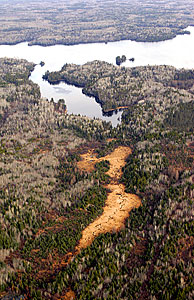Note: For the most up to date information on the Sierra Club’s efforts to stop sulfide mining, please see our Stop Sulfide Mining page, and blog.
 The proposed underground sulfide mining project by Twin Metals LLC in northeastern Minnesota includes over 30,000 acres containing disseminated mineralization of copper/nickel and associated trace metals bonded to sulfide ores. Located within the Superior National Forest approximately 10 miles east of Babbitt, 15 miles southeast of Ely, MN, and 2-3 miles from the Boundary Waters Canoe Area Wilderness (BWCA), the project was originally proposed by Franconia Minerals, which has since been absorbed by Twin Metals, a joint venture between Canadian Duluth Metals Ltd and Chilean Antofagasta PLC. The project currently includes the Birch Lake, Maturi, and Spruce Road deposits, with exploration continuing. The close proximity of the deposits to key water bodies such as the South Kawishiwi River, Birch Lake, the White Iron Chain of Lakes, and the BWCA create a potential for environmental destruction on an unprecedented level. In fact, the South Kawishiwi River was named one of America’s Most Endangered Rivers of 2013.
The proposed underground sulfide mining project by Twin Metals LLC in northeastern Minnesota includes over 30,000 acres containing disseminated mineralization of copper/nickel and associated trace metals bonded to sulfide ores. Located within the Superior National Forest approximately 10 miles east of Babbitt, 15 miles southeast of Ely, MN, and 2-3 miles from the Boundary Waters Canoe Area Wilderness (BWCA), the project was originally proposed by Franconia Minerals, which has since been absorbed by Twin Metals, a joint venture between Canadian Duluth Metals Ltd and Chilean Antofagasta PLC. The project currently includes the Birch Lake, Maturi, and Spruce Road deposits, with exploration continuing. The close proximity of the deposits to key water bodies such as the South Kawishiwi River, Birch Lake, the White Iron Chain of Lakes, and the BWCA create a potential for environmental destruction on an unprecedented level. In fact, the South Kawishiwi River was named one of America’s Most Endangered Rivers of 2013.
Twin Metals’ proposed underground mine is referred to as an “underground city” by Twin Metals (St. Paul Pioneer Press). Miles of tunnels would be blasted out below ground where dump trucks and massive earth moving equipment would extract tremendous amounts of material to be transported to the surface. Portions of the Twin Metals’ deposits might be deemed more economically feasible to mine as open pits.
Due to the low grade character of the rock formation, less than 1% of the ore would be produced as copper, nickel and trace metals, with waste rock comprising the remaining 99%. Since the amount of sulfur containing waste rock would be so enormous, the impact to the environment would be significant and long-term.
Although mining companies claim that they can “mitigate” such problems, there is currently no sulfide mine in existence that is not polluting the ground water. Acid Mine Drainage (AMD) and toxic heavy metal release can last for centuries; adversely affect fish and other aquatic life, wildlife dependent on those aquatic lives as food sources, and the quality of watersheds and drinking water. Sulfates (from sulfur) also leach into the environment and become part of a bio-chemical process that converts mercury into methyl mercury, which bio-accumulates in the food chain resulting in fish consumption advisories. Sulfates are particularly harmful to the growth of wild rice. Thus, pollutants from sulfide mining operations could adversely affect food sources and ultimately, human health. In addition, the scope of mining such low grade ores changes the landscape forever.
Advanced mineral exploration, including leasing and exploratory drilling, is now occurring on lands bordering the Boundary Waters and deep into the Superior National Forests and nearby state lands such as Bear Head Lake State Park and into the Cloquet Valley State Forest. Twin Metals is currently developing its mine plans and the company is expected to begin the permit application and environmental review process in 2014.